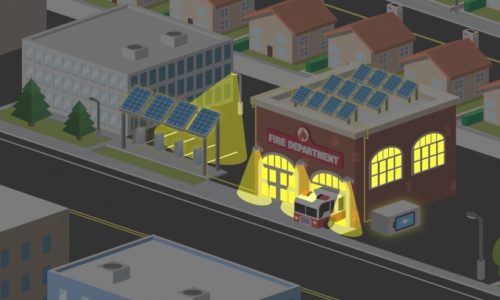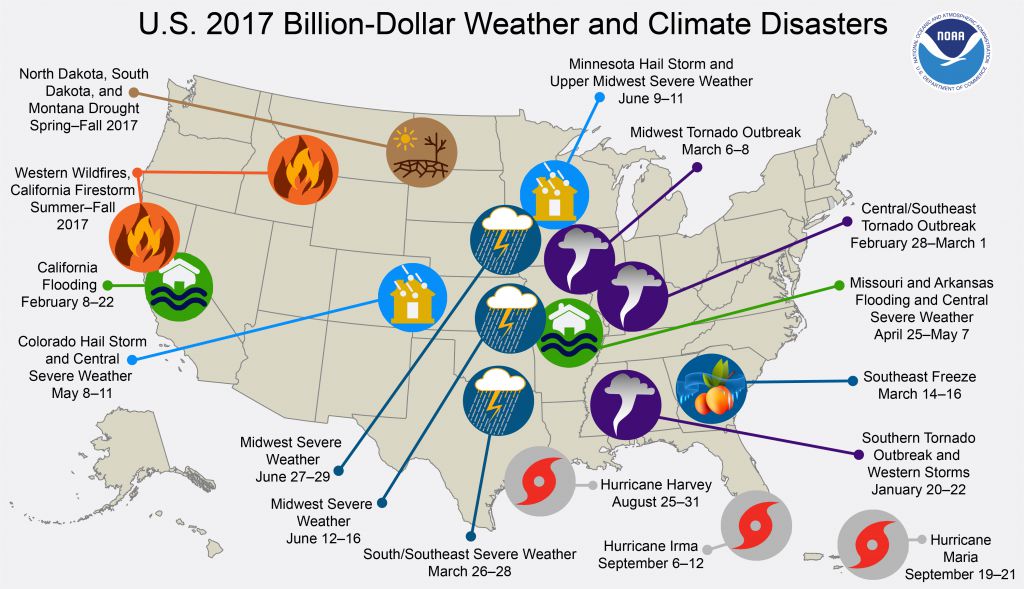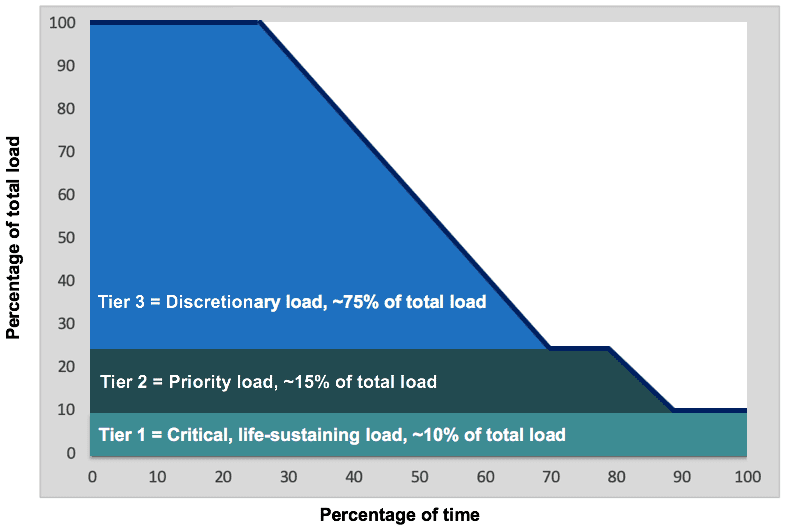
How a standardized Value of Resilience will proliferate Community Microgrids
The ability to easily comprehend the Value of Resilience (VOR) is key to unleashing the indefinite power backup capabilities of renewables-driven microgrids.
Energy resilience is a pressing need for our communities.
Our centralized energy infrastructure is costly, aging, and inefficient, which makes it highly vulnerable. Extreme weather events are occurring more frequently and causing extended power outages. From January through September 2017 alone, the U.S. experienced 16 weather-related events that incurred damage of at least $1 billion each. Recent wildfires, hurricanes, and floods have brought renewed attention to the vulnerability of our energy system.

It’s clear that we need energy resilience – and there’s no better way to provide that resilience than with renewables-driven Community Microgrids, which can keep critical loads online indefinitely during grid outages.
Why we need a standardized Value of Resilience (VOR)
While it’s not hard to convince people that indefinite, renewables-driven backup power for critical loads provides significant value, there is not yet an agreed-upon VOR for any type of loads, including critical loads at facilities that are the most vital: critical community facilities like fire stations, hospitals, emergency shelters, and critical water and communications facilities.
A VOR standard is sorely needed, and its absence represents a significant gap in the market for Community Microgrids. As Microgrid Knowledge has noted, valuing resilience “is not so simple, yet may be the primary reason an organization installs a microgrid.” The issue is not limited to facilities considering a microgrid. Regulators need to consider VOR when conducting resource planning, but they are currently unable to do so because of a lack of standard values. Utilities wishing to engage in microgrid pilots have had their requests denied because they were not able to quantify the VOR.
At the Clean Coalition, we’re paving the way to unleash the renewables-driven microgrid market. Our goal is to make it simple to quantify VOR, starting with our Value of Resilience (VOR) methodology, which standardizes VOR for Tier 1, 2, and 3 loads across all facility types. For example, Tier 1 loads are worth the same whether at a hospital or a fire station. Tier 1 loads are of a mission-critical life-sustaining nature; the only difference between facility types is how much of the normal load is Tier 1. Hospitals generally have high percentages of Tier 1 loads, on the order of 50%, while fire stations have a relatively low percentage, in the 10% range, which is close to the norm for the majority of facilities.
This normalization of the load tiers is key to standardizing VOR. Currently, one needs to go through an elaborate forensic accounting VOR process for every facility, which is why VOR is rarely analyzed and available for monetization.The Clean Coalition’s VOR methodology, VOR123, fixes that by providing a standardized VOR for Tier 1, 2, and 3 loads based on the average kilowatts (kW) in each tier. That means that one only needs to know a facility’s annual energy usage in kilowatt-hours (kWh), divide by 8,760 hours/year, and approximate its percentages of total load that are Tier 1, 2, and 3 – and then apply the established VOR123 values.
If you have experience discussing VOR with property owners, tenants, facility managers, policymakers, and utilities or other load-serving entities, you will greatly appreciate the huge advancement that VOR123 is staged to bring to the Community Microgrid market. Standardized VOR will allow all stakeholders to effectively consider VOR when analyzing Community Microgrid economics. This will result in Community Microgrids being widely deployed, and far greater resilience for communities.
Evaluating resilience in terms of critical load
The Clean Coalition defines resilience as the ability to keep critical loads online indefinitely during grid outages.
What is a critical load? It’s one that is considered life-sustaining or mission-critical and therefore has high value to being kept operational at all times, including during grid outages. For a community, critical loads tend to be first responders such as fire stations, police stations, and hospitals; emergency shelters such as schools; and other critical services such as water departments, gas stations, stores, and communications infrastructure. Across facilities, critical load percentages will vary – for example, a hospital will normally consider much more of its load to be critical than a fire station or office building, but buildings that house data centers, scientific activities, and/or industrial processes could have high critical loads.
Although facilities and communities have different needs, we can define critical loads in terms of typical percentages of total electric load:
- Tier 1 = Critical load, usually 10% of total load: Life-sustaining or crucial to keep operational during a grid outage
- Tier 2 = Priority load, usually 15%: Important but not absolutely crucial to keep operational during an outage
- Tier 3 = Discretionary load, usually 75%: Remainder of the total load
Establishing a methodology on these load tiers ensures that the methodology can be easily applied to any type of facility. What’s important is not the type or size of a facility, but rather the stratification of its load across the three tiers. Each facility can determine how it wants to stratify between Tier 1, 2, and 3 loads.
Solar+storage power backup
The Clean Coalition is staging numerous solar+storage Community Microgrids that are designed to deliver indefinite renewables-driven backup power to critical loads. Until the VOR123 efforts produce standardized values, we are using the utility industry cost-of-service (COS) methodology to evaluate the costs associated with provisioning indefinite renewables-driven backup power to Tier 1 loads using solar+storage, combined with load shedding when Tier 2 and 3 loads need to be shut off in order to preserve energy for indefinite power backup of Tier 1 loads. Ultimately, the key analysis is determining how much solar+storage is required to keep Tier 1 loads online indefinitely, even on the most unfavorable solar day, based on decades of historical weather data.
Of course, grid outages often occur at times of high solar resource. In a typical California-based scenario, with Tier 1 loads representing 10% of the normal load, the Clean Coalition estimates that solar+storage microgrids that are sized for indefinite renewables-driven backup power of Tier 1 loads will be able to keep all Tier 2 loads online about 90% of the time, and will be able to keep Tier 3 loads online about 50% of the time.

This level of resilience is in stark contrast to that provided by diesel generators. While diesel generators are often sized to back up either Tier 1 loads only, Tier 1 and 2 loads only, or entire loads, they generally have only enough onsite diesel fuel to provide backup power for about two days. Even if they have more diesel fuel available, once it runs out, all fossil fuels may be impossible to replenish during serious disasters (this includes natural gas, which is unavailable for very long durations when its pipelines rupture and/or explode – or are at risk of doing so). In addition, operations and maintenance (O&M) for diesel generators is expensive because they require regular exercising to remain in working order. And EPA requirements for particulate filters can dramatically increase the capital costs of diesel generators for commercial and industrial customers, and greatly limit their allowed runtimes.
Get involved
The Clean Coalition is working to formalize the VOR123 methodology and standardized values, and to gain industry alignment for them. We have already engaged on our VOR123 work with a number of key stakeholders, including governmental, nonprofit, corporate, and other organizations.
As we continue refining the methodology, we welcome involvement and input from interested parties. If you’d like to learn more, please contact us.

